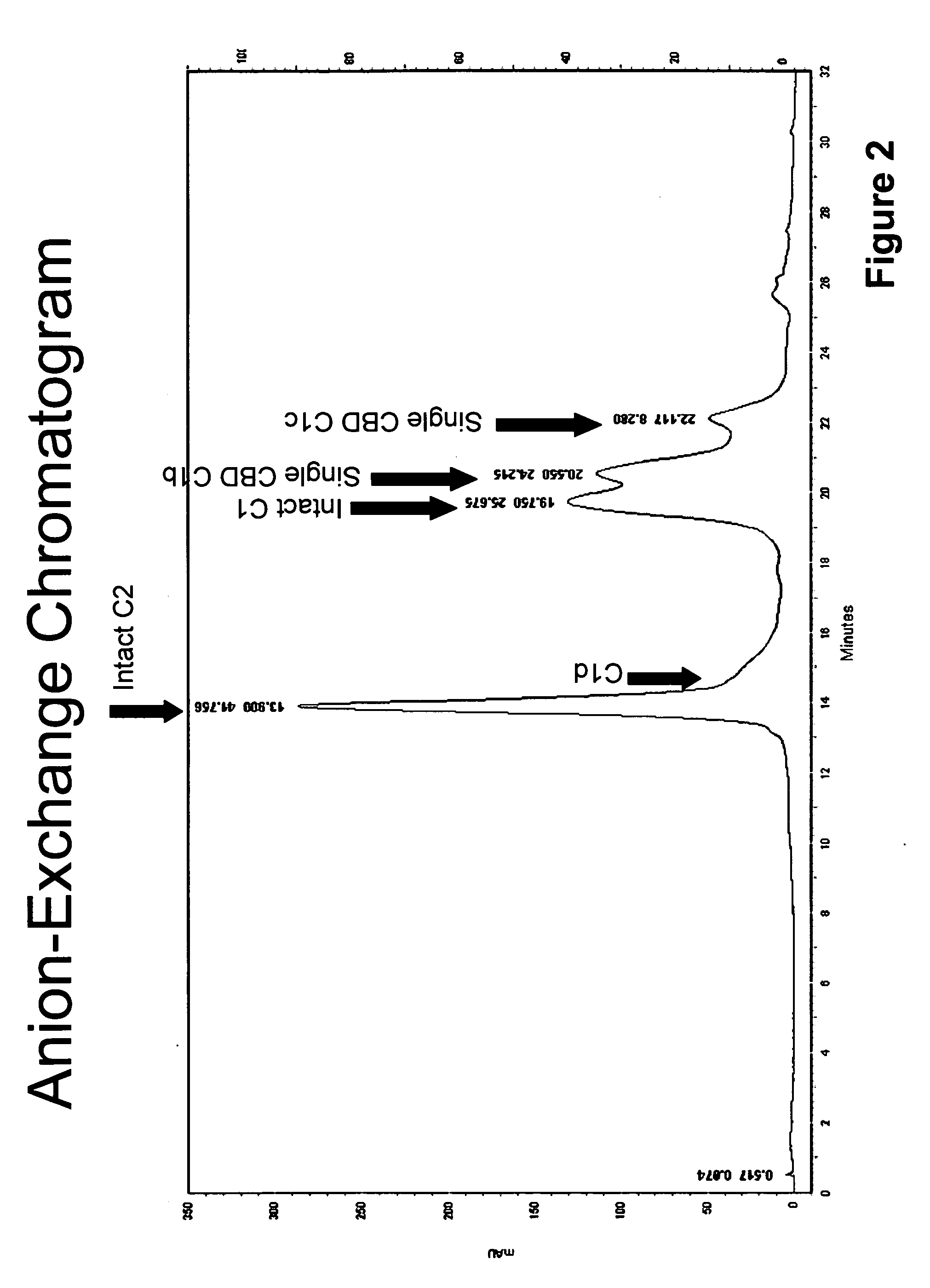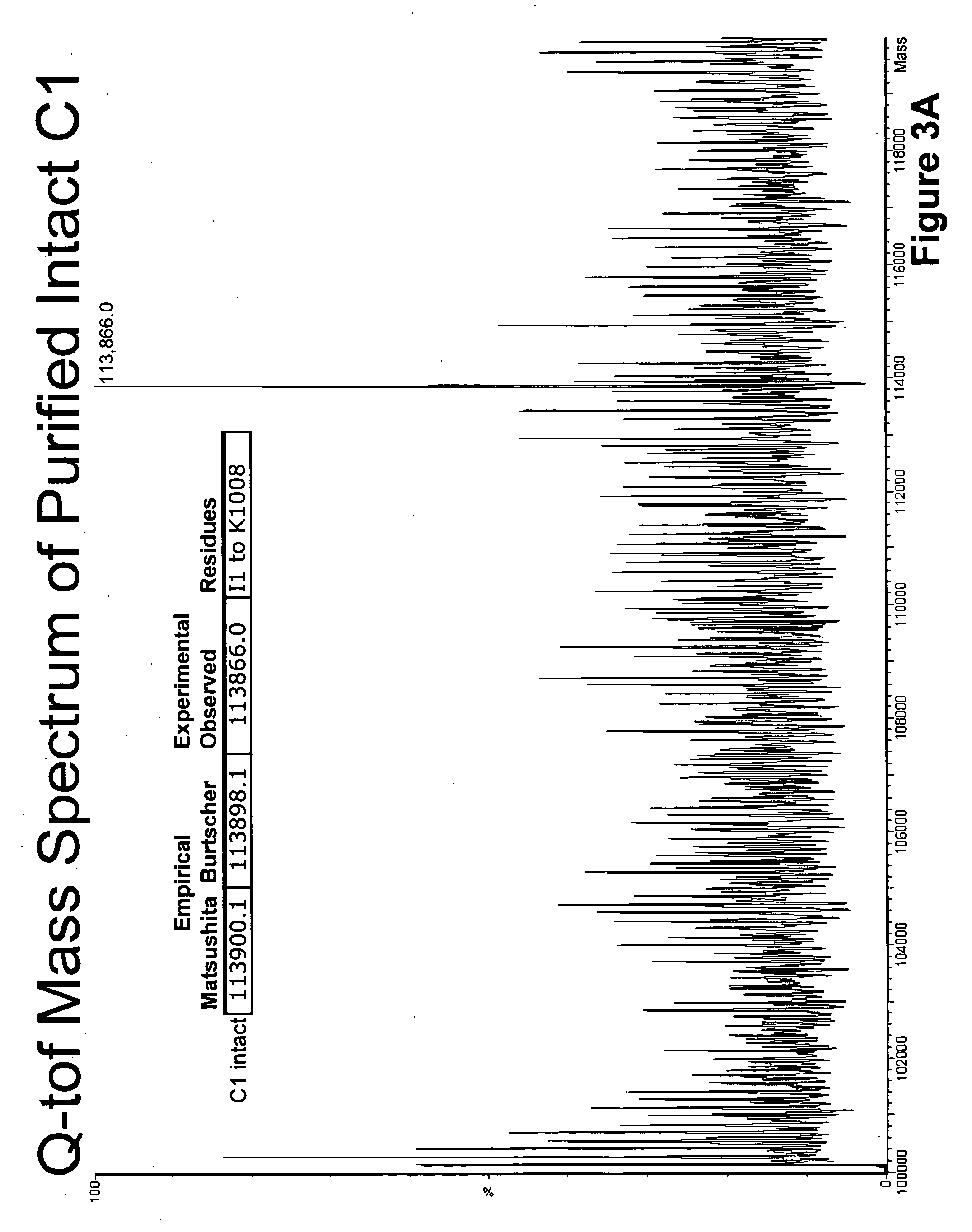Protease resistant recombinant bacterial collagenases
a bacterial collagenase and protease technology, applied in the field of protease resistance recombinant collagenase enzymes, can solve the problems of preventing the commercialization of collagenase-based technology from reaching its full potential, unable to achieve the consistency desired for research and/or therapeutic applications, and unable to fully resolve many degraded forms from the intact forms without significant reduction in recovered enzymes. , to achieve the effect of reducing the sensitivity of pro
- Summary
- Abstract
- Description
- Claims
- Application Information
AI Technical Summary
Benefits of technology
Problems solved by technology
Method used
Image
Examples
example 1
Purification of Collagenase C1 and C2 and their Proteolytic Fragments from Natural Fermentation Media
[0035]The crude collagenase in this work is prepared using minor modifications of the protocol of Warren & Gray. Analysis of this material and crude collagenase samples from different vendors by analytical Mono Q HPLC revealed the same approximate distribution of holo and proteolyzed collagenase enzymes. This material differs from the other crude collagenase samples in having a lower than average clostripain and neutral preotase concentrations classifying it as a low protease crude collagenase material.
[0036]Preliminary enzyme purification was accomplished by hydrophobic interaction chromatography on a hexyl agarose support similar to the protocol reported in the U.S. Patent Application Publication US 2007 / 0224183 A1 by Sebatino, et al. Both sodium chloride and ammonium sulfate were found to be able to induce binding of the collagenase while allowing the bulk of the fermentation by-p...
example 2
Analysis of Natural C. Histolyticum Collagenase C1 Mass Spectra Data
[0038]The two gene derived amino acid sequences of the mature C. histolyticum C1 enzyme are shown in TABLE 1 appearing below. The complete sequence of Matsushita is shown in its entirety. The sequence reported by Burtscher contains only four differences and are identified at the appropriate positions. Both sequences code for mature proteins of 1008 amino acid residues with an empirical mass difference of 2 daltons (atomic mass units AMUs).
TABLE 1C1 AMINO ACID PROTEIN SEQUENCE 10 20 30 40 50 60IANTNSEKYDFEYLNGLSYTELTNLIKNIKWNQINGLFNYSTGSQKFFGDKNRVQAIINA 70 80 90 100 110 120LQESGRTYTANDMKGIETFTEVLRAGFYLGYYNDGLSYLNDRNFQDKCIPAMIAIQKNPN 130 140 150 160 170 180FKLGTAVQDEVITSLGKLIGNASANAEVVNNCVPVLKQFRENLNQYAPDYVKGTAVNELI 190 200 210 220 230 240KGIEFDFSGAAYEKDVKTMPWYGKIDPFI...
example 3
Analysis of Natural C. histolyticum Collagenase Class 1b Mass Spectra Data
[0040]After purification a highly homogeneous sample of the C1b protein was recovered. The deconvoluted mass spectra results observed here along with a representative SDS-PAGE gel is shown in FIGS. 4A, 4B. The observed mass of this enzyme fragment is 101,033 AMUs is 12,833 AMUs less than the parent molecule. Fragmentation of the Matsushita and Burtscher proteins between lysine 896 and leucine 897 would provide fragments with molecular masses of 101,066 and 101,064 AMUs, which represent losses of 12,834 AMUs, respectively. Within the error of analysis this is considered a very high probability match. From x-ray crystallographic analysis this proteolysis site is located between the two collagen binding domains of the molecule. Collagen degrading activity analysis of this molecule is consistent with the observations of Matsushita that showed the loss of the second collagen binding domain results in a significant ...
PUM
| Property | Measurement | Unit |
|---|---|---|
| temperatures | aaaaa | aaaaa |
| mass difference | aaaaa | aaaaa |
| molecular mass | aaaaa | aaaaa |
Abstract
Description
Claims
Application Information
 Login to View More
Login to View More - R&D
- Intellectual Property
- Life Sciences
- Materials
- Tech Scout
- Unparalleled Data Quality
- Higher Quality Content
- 60% Fewer Hallucinations
Browse by: Latest US Patents, China's latest patents, Technical Efficacy Thesaurus, Application Domain, Technology Topic, Popular Technical Reports.
© 2025 PatSnap. All rights reserved.Legal|Privacy policy|Modern Slavery Act Transparency Statement|Sitemap|About US| Contact US: help@patsnap.com



